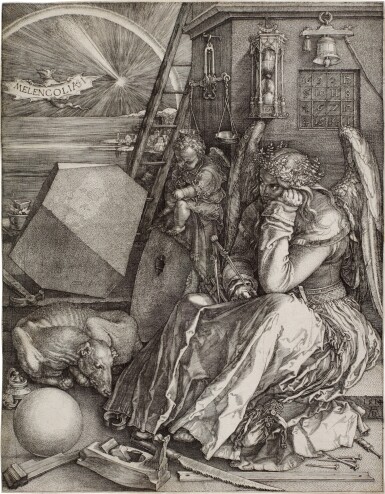Old Master Prints
Old Master Prints

Property from the Estate of George Embiricos
Albrecht Dürer
Melencolia I (Bartsch 74; Meder, Hollstein 75)
Lot Closed
December 8, 02:02 PM GMT
Estimate
150,000 - 250,000 GBP
Lot Details
Description
Albrecht Dürer
1471 - 1528
Melencolia I (Bartsch 74; Meder, Hollstein 75)
Engraving, 1514, a very fine, early, silvery Meder IIa impression, printing with remarkable clarity and sparkling contrasts, the figure’s face dark, on laid paper without watermark as called for by Meder for early impressions, framed
sheet: 241 by 187mm 9½ by 7¼in
With Colnaghi, their stock number c.304295 in pencil verso, sold to Marshall Field Co., 16 August 1898
The present impression compares well with the Sloane and Malcolm impressions in the British Museum.
Dürer’s masterful engraving of the enigmatic Melencolia has both captivated and mystified viewers since its creation in 1514. Along with Knight, Death, and the Devil and Saint Jerome in His Study, Melencolia I completes Dürer’s so-called Meisterstiche (master engravings). In these mature works, created in 1513 and 1514, the artist reached the pinnacle of his abilities as an engraver. Aside from their technical virtuosity, the three prints are connected by their analogous formats, and through their depictions of solitary figures within intricately detailed and highly symbolic settings. The Meisterstiche also correspond to the three kinds of virtue espoused in medieval philosophy: moral, theological, and intellectual; together they capture the complexity of contemporary thought.
In this engraving, the central winged female figure represents a personification of Melancholy itself, as identified by the scroll at the upper left. While scholars have debated numerous readings of this work, a prevailing theory links the figure of Melencolia to Hippocrates’ humoral theory, which argues that human temperament is controlled by four different humours: black bile, yellow bile, blood, and phlegm. Each of these humours was associated with a respective emotion, with the excess of black bile linked to melancholy. While melancholy was initially regarded as one of the least desirable of the four humours, Renaissance thinkers redefined the melancholic temperament as related to genius and creativity.
Here the figure of melancholy is portrayed as deep in thought with her chin resting in one hand and a caliper held in the other; she is thus transformed into an allegorical emblem of the tortured artist, and perhaps even a psychological self-portrait of Dürer himself. Although she is surrounded by a litany of intellectual iconography including an hourglass, set of scales, and magic square (the grid of numbers on the back wall in which each row and column adds up to 34), Melencolia herself appears paralysed, with a dejected, hollow stare. Her frustration is echoed by the fact that despite her wings, she remains tethered to earth, presumably unable to fly. Art historian Suzanne Boorsh argues that Melencolia’s powerlessness within this scene is perhaps a reflection of Dürer’s own creative struggles and the immense pressure he felt as an artist to achieve perfection in his own work.
The present impression is a particularly early example of Dürer’s iconic engraving, printing richly, especially in the figure’s face, with shimmering contrasts in the sea, sky and drapery. It compares favourably with the very fine Sloane and Malcolm impressions in the collection of the British Museum, further indicating that this example must have been pulled at an early stage, when impressions still exhibited all of the qualities Dürer envisaged when he engraved the plate.
‘A work which amazed the world’ - Giorgio Vasari
